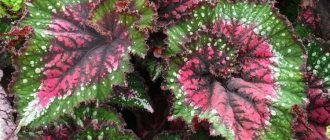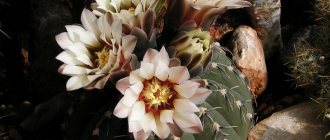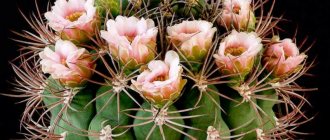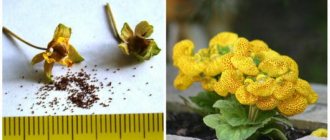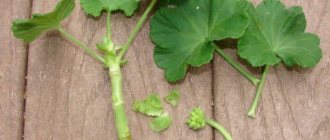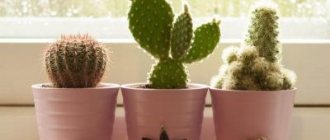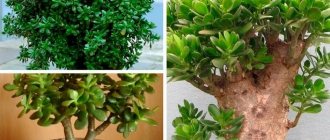Botanical description
The houseplant Gymnocalycium denudatum in Latin is a representative of the genus Gymnocalycium. The species was discovered by Friedrich Zellow in 1825, finding it in Uruguay.
The stems of the plant are round, 9-11 cm in diameter. Side shoots are formed in the lower near-root part. The surface of Denudatum is smooth, shiny, and green in color. The entire cactus is divided into 5-6 lobes or ribs, delimited by vertical shallow grooves.
The cactus has only radial spines, arranged in groups of 4-5 pieces, and in the root zone 7-8 pieces. These spines grow up to 1 cm in length, are pale yellow in color, curved in shape, and are adjacent to the stem.
During the flowering period, an elongated flower tube rises from the center of the cactus, and the flower itself reaches 4-6 centimeters in height. The flower is beige-yellow, wide, with bent petals.
Plant ⌀ 5 Gymnocalycium RAGONESEI (Gymnocalycium)
Gymnocalycium RAGONESEI - Gymnocalycium Ragonese.
Characteristics: One or more plants in a technical pot with a diameter of 5 cm without a flower pot (first photo). The pots can be purchased separately here.
Description: Gymnocalycium is a spherical cactus native to South America, whose name comes from the Latin words “gymnos” - “naked” and “calycium” - “cup”. It grows in South America (Argentina, Brazil, Bolivia, Uruguay, Paraguay), at an altitude of 800-3000 m above sea level, on granite and gneiss soils, as well as in campos on clay soils. Gymnocalyciums are valued for their beautiful stem shapes and large flowers. The flower tubes of this plant, unlike other cacti, are bare (without hairs or bristles), covered with smooth scales. They are formed from areoles at the top of the stem. Plants with a spherical, flattened stem; the diameter of adult specimens ranges from 4 to 15 cm, while the height of the plants is approximately half the diameter.
The color of the stem is usually grayish-green (sometimes almost gray) or brownish-green (sometimes almost brown). Among the cultivars there are plants with red and yellow stem colors; These achlorophyllous cacti can only grow when grafted onto another green cactus. The stems are mostly ribbed. On the ribs there are “chin-shaped” tubercles. The flowers are red, pink, white, yellow, greenish or brownish yellow with a short floral tube.
Gymnocalycium Ragonese is the smallest cactus of the genus. The stem is miniature, flat-spherical, up to 5 cm in diameter and up to 2.5 cm in height. It has a red-brown epidermis. There are about 10 ribs, they are flat, separated from each other by shallow grooves. There are 6 radial spines. They are small, thin, whitish, pressed to the stem. The flowers are white, with a characteristic thin tube, up to 5 cm long. Its homeland is an area on the border of the Argentine provinces of Cordoba and Catamarca, where it grows at an altitude of approximately 400 meters.
Care: Moderate temperatures from spring to autumn. In winter, it is advisable to maintain a temperature of 15-18°C; it can be kept at a lower temperature, down to 5°C. Plants placed on window sills in an unheated room are best brought into the room on cold nights. Photophilous, requires bright light, especially in winter. When kept in a greenhouse during the hot season, shading may be required. In the spring, watering gradually increases; from late spring to late summer, the watering regime is the same as for other indoor plants, i.e. as needed, preferably with warm water. From the end of summer, watering is reduced and from mid-autumn it is sharply limited - water occasionally and little by little. Does not require spraying in summer. Demanding of fresh air - windows should be opened on hot days.
Replant annually at a young age, subsequently as needed in the spring. The new pot should be only slightly larger than the old one. For most species, cuttings take root easily in spring or summer. The cuttings are dried for several days (large cuttings will require 1-2 weeks) before planting in a peat-based substrate. Reproduction under seeds is possible at 17-25°C. Sowing is superficial, without deepening into a cactus mixture diluted by half with sand. The mixture is moistened with a spray bottle and covered with glass or film. Germination in light, but not in the sun.
What is another name?
The plant was originally named Echinocactus denudatus , but in 1845 the name was changed to Gymnocalycium denudatum. Also, this succulent is called Cereus denudatus.
In addition, this species has 3 subspecies, namely: Gymnocalycium denudatum var. roseiflorum, Gymnocalycium denudatum var. bruennowii and Gymnocalycium denudatum var. paraguayense. These varieties are considered synonymous names for the main branch (read more about other types of Gymnocalycium here). The broad masses call this cactus “Spider”.
Reproduction by seeds and shoots
Seeds
Gymnocalicium flowers do not self-pollinate. Two unrelated hymnocalicium (preferably different subspecies) are required for successful pollination and seed production.
Conditions for seed propagation:
- Germination varies from 2-5 days to one month, since some species have large seeds with a durable shell.
- An important condition for good seed germination is temperature. The optimal range for most species is the temperature range of +23-25 °C.
- Extreme temperatures - below +12 °C and above +28 °C - do not promote germination.
For most species, the highest germination percentage is at a constant temperature of +25 °C. The best time for sowing is the third ten days of February.
Step by step planting seeds:
- Planted in moist soil, covered with film.
- Be sure to open the soil for 10 minutes a day and remove excess moisture from the film. Watering should be done once every 4-5 days.
- The seedlings will hatch in 3-2 weeks. You can plant them after the thorns appear.
Differences between Denudatum and other species
Unlike Gymnocalycium denudatum var. paraguayense, the original species does not have a large number of bumps on the surface, while in Denudatum it is smooth. Also, the flower of the latter plant is pale yellow or cream, while that of paraguayense is exclusively white.
Gymnocalycium denudatum var. bruennowii has a more teardrop-shaped shoot than the classic Gymnocalycium.
Gymnocalycium denudatum var. roseiflorum can be distinguished from Gymnocalycium denudatum by its flower, since the first cactus has a wide flower with long petals and pink color.
Home care
Gymnocalycium is an unpretentious plant and even a novice gardener can take care of it. However, there are several conditions that must be met:
- In order for the various types of Gymnocalicium flowers to grow well in winter, additional lighting is recommended. In summer, during peak heat - from 4 to 12 o'clock in the afternoon - it is recommended to slightly shade the place so that the cacti do not burn.
- Gymnocalycium loves high temperatures - at least 20 degrees. The optimal temperature for it will be 24-25 °C; in summer they can withstand up to 35 degrees of heat.
- Rare watering - Gymnocalycium does not tolerate excess moisture. Therefore, they should only be watered when the soil is dry. In spring, summer - once a week, in winter - up to three times per season.
- The soil should be loose with a neutral reaction. You can use a special composition for cacti. If you wish, you can make a suitable substrate yourself - mix charcoal, sand and peat in equal proportions.
- When creating a composition, it is better to use a shallow rectangular container - the plants should “feel” the bottom with their roots.
- Gymnocalycium needs fertilizer only in the warm season. You can feed it with mineral fertilizers with a low nitrogen content; organic compounds are contraindicated. In winter, the cactus goes into retirement, so feeding should be stopped.
Trimming
Pruning is only necessary when the cactus begins to rot and urgently needs to be revived.
- Cut off any rotten areas.
- The plant is then left on the surface for several days.
- After this time, hymnocalicium should be planted in a suitable pot.
Pruning is also used when grafting one cactus to another. Cuts of the same shape and size are made on both plants. Then the cacti are connected and secured with an elastic band.
How to transplant?
Transplantation of adult plants occurs once every 2-3 years and only as they grow.
Young cacti should be replanted more often - once a year. The diameter of the pot should be slightly larger than the previous one. Carefully remove the cactus from the pot and rinse the roots with warm water. Leave it on a dry surface for 1-2 days. After this, plant in fresh soil.
How to care at home?
Like many other succulents, Gymnocalycium nuda is unpretentious. If you follow the primitive rules of care, the cactus will bloom regularly and delight the gardener.
Temperature
Gymnocalycium is a heat-loving plant. In summer, favorable temperatures range from 20-30 degrees Celsius. With the decrease in air temperature in nature, the temperature of the content should also be reduced. So, in winter it can be reduced to 16 degrees above zero.
In winter, the plant goes through a dormant period, when temperature and watering are greatly reduced. The minimum permissible temperature is 8 degrees above zero.
Watering
The most important thing in watering is its balance. During the warm season, watering must be done when the soil dries out. In cold winter times, watering is reduced to a minimum; the soil should be moistened occasionally.
Light
The plant is light-loving. It prefers abundant, but not hot and diffused lighting. Direct sunlight will harm the plant and damage its epidermis.
Priming
To maintain growth, Gymnocalycium requires soil with above-average acidity and should contain peat, turf and leaf soil, and coarse sand.
Trimming
Since the cactus does not have individual leaves, pruning involves removing the children. Separation should be done carefully so as not to damage the mother shoot.
Feeding
It is worth noting that Denudatum only accepts mineral fertilizers! It is worth feeding the cactus only in spring and summer, no more than three times a week. The rest of the time, no feeding is required.
Pot
The size of the pot should vary depending on the size of the succulent. The pot may not be wide, but it must be deep enough and have drainage.
Transfer
- It is necessary to clear the roots from the soil.
- Rinse the root part with hot water and dry. It takes two days to dry.
- After the operations have been completed, you can place the plant in a new pot with the soil composition described above.
Wintering
The dormant period of Gymnocalycium occurs in winter. During this period of time, no feeding is done, watering is done rarely so that the plant does not dry out, the temperature drops to 14-16 degrees Celsius. The location of the flower does not need to be changed.
Types of Gymnocalycium
Gymnocalycium mihanovichii
Plant sale
Gymnocalycium Mihanovichii variegata
1900 rub. 2800 rub.
Gymnocalycium Friedrichii Agua Dulce
390 rub. 500 rub.
Gymnocalycium Mihanovichii
95 rub. 200 rub.
A charming little cactus from Paraguay. Gymnocalycium mihanovichii pleases with its interesting structure and spectacular flowering. It grows to approximately 4 cm in height and 6 cm in diameter. The plant forms a thick, spherical shoot, divided into triangular, deep, pointed ribs. Along the edges there are characteristic projections ending in large woolly white areoles from which sharp, hooked spines grow. The surface of the shoot is dark green, sometimes purple, and the edges of the ribs and notches are emphasized by a light creamy green edge. During flowering, large, beautiful light pink flowers appear at the tops of the stems.
Gymnocalycium andreae
It is a low, spiny cactus, barely rising above ground level, usually solitary in its habitat, but often branching at the base when cultivated, forming clusters 15 cm or more wide. This species differs from ordinary Gymnocalyciums in the color of its flowers, in this case a brilliant sulfur yellow.
Gymnocalycium baldianum
An unusual cactus native to mountainous and grassy areas of Argentina. Produces a spherical, slightly flattened shoot with a diameter of about 13 cm. The surface of the stem is divided into approximately 9-11 rather wide ribs of a dark green, black color, interrupted by shades of gray. The plant is additionally decorated with curved shining cream-colored spines. It is because of their shape and arrangement that Gymnocalycium baldianum is also called the “spider cactus”. In early summer, large, intense purple-red flowers appear on thick, upright stems. Refers to cacti valued for their expressive and abundant flowering.
Bruch's Gymnocalycium bruchii
It is a miniature succulent that grows in clusters when small. This species is very variable and has received many names. The stems are flattened, blue-green, thick, up to 4 cm in diameter, 6 cm long. The spines are white, bristly, straight or curved. Flowers: Bell-shaped to funnel-shaped, 6 cm wide, in early spring with an unusual shade of lavender-white, followed by green fruits. This slow-growing plant will eventually form clusters up to 15 cm in diameter. Depending on the length of the radial spines and their number, the following forms of this species are distinguished: Gymnocalycium bruchii f. niveum and Gymnocalycium bruchii f. albispinum.
Green Gymnocalycium (Gymnocalycium calochlorum)
A small, flattened cactus that forms low, flat clusters of many stems that grow at soil level. The spines are thin, mostly pinkish-brown. The light pink flowers are trumpet-shaped, over 5cm at their widest point. They don't open completely. The stem in its natural habitat is solitary to very lumpy, depressed-spherical, about 6 cm wide and 4 cm tall, shining pale green, gray-green or blue-green.
Gymnocalycium carminanthum
Best known in cultivation as Gymnocalycium carminanthum, it is a single stem species, small in size, with thick spines, slightly curved inward, which is especially attractive for its beautiful bright carmine-red flowers. It grows at altitudes between 1300 and 1800 m above sea level, but except for the color of the flowers it is the same as Gymnocalycium oenanthemum and is difficult to distinguish.
Gymnocalycium denudatum
A small, spherical, usually unbranched cactus with a glossy dark green body and rounded ribs. Gymnocalycium denudatum is extremely diverse. Stem: single, broadly globose, depressed, globose or hemispherical, 2-3 cm in height and 6-8 cm in diameter (up to 10 cm in height and 15 cm in diameter in cultivation), glossy gray-green to dark -green.
Gymnocalycium gibbosum
Small single cactus. This is a fairly variable species. This polymorphism has led some authors to describe many unnecessary varieties. Stem: Deep greyish green, olive green, brown to grey-black, discoid, lengthening over time 10-25 cm tall, up to 12 cm in diameter, apex slightly pubescent. Ribs: 10-16 straight, separated by well-defined angular ribs.
Gymnocalycium saglionis
A single barrel-shaped cactus, rather flattened, often very large, with long spreading and sometimes curved spines. They are a rich brown color and contrast nicely with the grey-green body. Stem: flattened globose to short cylindrical, more or less flattened to 30 (40) cm in diameter, 15-30 cm tall, sometimes up to 90 cm tall, dull green or blue-green. Vertex
Reproduction
This cactus can be propagated in two ways: using seeds or lateral shoots.
Seeds
The most effective, but at the same time the most difficult method of reproduction. It produces good offspring, but cultivation takes a long time. For this reproduction you will need:
- Buy a substrate for this succulent.
- Steam the substrate at high temperature in the oven to disinfect the soil.
- Moisten the soil and place the seeds in it.
- The soil must be kept moist at all times.
- Initially, you can plant the seeds in a small and shallow pot.
- To prevent moisture from evaporating, you can cover the pot with film or cover it with a transparent lid.
- Gymnocalycium will germinate quickly at 20 degrees Celsius and abundant but diffuse lighting.
- In a year it will be possible to transplant.
By shoots
Reproduction by shoots occurs quite quickly and uncomplicated. The plant develops rapidly, but you need to be careful in handling when separating and planting the plant.
- Separate the shoots from the stem.
- Let the babies dry for a couple of days.
- Place them in moist soil.
- Conditions and care are the same as for an adult plant.
Reproduction of Gymnocalycium
Gymnocalycium is propagated by seeds and offspring, and non-chlorophyll species by grafting.
Those Gymnocalyciums that form children are very easy to propagate: daughter plants are removed from the mother plant, dried for a day or two, and then planted in a damp mixture of sand and peat. Children usually form roots very quickly. They care for the planted shoots, just like an adult cactus.
In the photo: Growing Gymnocalycium in a pot
However, for most species of Gymnocalycium, the main method of reproduction is by seed. And for those plants that can be propagated vegetatively, the seed method is more reliable. To grow a cactus from seeds, you will need the same substrate as for an adult Gymnocalycium, but the fractions of which it consists should be smaller.
The soil mixture must be disinfected by heating it in the oven, after which it is allowed to cool, placed in cups and moistened.
Gymnocalycium seeds are planted shallowly. The crops are kept in a bright place at a temperature of 20 ˚C, the substrate is kept slightly moist by spraying it with a sprayer.
As for grafting, for this method, a completely healthy rootstock and scion are selected and identical sections are made on them immediately before grafting with a sharp, sterile instrument. The stock is applied to the scion, trying to combine the conductive bundles as much as possible, and they are fixed in this position for 7-8 days using an elastic band or tape.
Diseases
The appearance of yellow spots on the plant are traces of a red flat mite. This is a small but quite harmful insect that terrorizes young individuals. To get rid of it you only need hot water and a little ethyl alcohol.
An equally terrible threat to Gymnocalycium is root rot. Its appearance can be caused by waterlogging of the soil, its incorrect composition or a violation of the temperature regime. Rot can be removed by washing the cactus roots with water, removing infected parts, treating the roots with crushed coal and drying them.
Pests and diseases
Gymnocalycium is disease resistant, but it can develop root rot, which can lead to death. This is caused by overwatering or planting in too fertile soil. In this case, you need to remove the affected root shoots and treat the plant with a fungicidal agent.
This type of plant is characterized by infection:
- flat mite - an unpleasant pest that attacks young cacti, its presence is manifested by brown spots on the stem; when there are few of them, you should wash the cactus with warm soapy water;
- mealyworm - affects cactus at any age and damages the roots and base of the stem; To destroy it, you need to treat the cactus with an insecticide.
Similar plants
Representatives of the genus Gymnocalycium are similar to each other.
- For example, Gymnocalycium Baldus is quite similar to the naked one. Only the first one has more pronounced processes, spines and a red flower.
- Erinaceum differs from Denudatum only in the presence of spines and a lumpy surface.
- Anizitsi has something similar to mountain ridges on its segments, on which there are shoots and spines, and the flower has a pleasant pink color.
- The “bright red gymnocalycium” species is similar to the Naked one, however, the processes of the former entwine the surface of the cactus and the flower is light or dark red in color.
- Andre's species is smaller in size than Denudatum, but has a similar structure and flower.
Gymnocalycium Denudatum is a beautiful, compact and exotic plant. It will definitely appeal to collectors and hobbyists. Owning it will become a pleasant feature of your interior, emphasizing your love for nature and high aesthetic taste. By adhering to the rules outlined in this article, you can grow a worthy specimen of a beautiful plant.
There are a huge number of varieties of Gymnocalycium. Read about the secrets of growing Japanese, as well as Saglionis and mix varieties, on our Internet portal.
How to care for a plant at home
The process of caring for Gymnocalycium is simple and understandable even for novice gardeners.
Did you know? It is no secret that cacti are drought-resistant - they provide themselves with a supply of moisture, accumulating it inside themselves. Thus, about 80% of the total mass of the plant is water.
Watering rules
Perhaps, proper watering is the basis for the successful cultivation of a cactus, so it is important to follow the general recommendations:
- water only with soft, settled or filtered water (the plant does not tolerate chlorine and hard water);
- Allow the soil in the pot to dry completely between waterings;
- water at the root and do not allow a large amount of water to get on the stem of the plant;
- use water at room temperature (not lower than +18°C);
- use drainage to prevent stagnation of water in the lower part of the pot;
- adjust the intensity depending on the time of year: in summer more frequent and abundant watering, in autumn - half as often, in winter Gymnocalycium does not need additional moisture at all until April.
Top dressing
A distinctive feature of the plant is its complete intolerance to organic fertilizers, so the cactus can only be fed with mineral fertilizers. It is better to use ready-made products for succulents and cacti, sold in flower shops, strictly following the instructions.
The plant should be fertilized only during the growing season, that is, from April to the end of September, combining fertilizing with watering once a month. In winter, while the flower is dormant, it does not need additional nutrients.
Learn more about how to properly care for cacti at home.
Transfer
Gymnocalycium grows very slowly, so there is no need to replant it often. Transshipment of young plants is carried out once a year (in spring), then once the flower reaches the age of 3 years - once every 2-3 years as necessary.
To correctly carry out the procedure for relocating a flower to a new container, you need to proceed in stages:
- prepare a new pot - it should be slightly larger than the previous one;
- pull the plant out of the ground, remove damaged parts of the roots;
- rinse the root in water;
- let the root system dry for 2 days;
- prepare a substrate from turf, sand, peat and leaf mixture in equal proportions - it is recommended to use a ready-made purchased mixture for cacti;
- Place a 1 cm thick layer of drainage granules at the bottom of the pot, then fill the container with soil and plant the cactus in it;
- sprinkle with soil, compact, water the soil with soft water.
